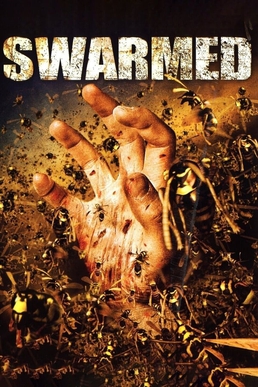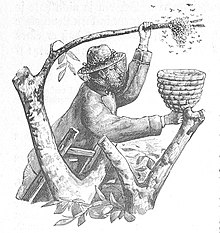
Arachnophobia is the fear of spiders and other arachnids such as scorpions and ticks. The word Arachnophobia comes from the Greek words arachne and phobia.

Bees are winged insects closely related to wasps and ants, known for their roles in pollination and, in the case of the best-known bee species, the western honey bee, for producing honey. Bees are a monophyletic lineage within the superfamily Apoidea. They are currently considered a clade, called Anthophila. There are over 20,000 known species of bees in seven recognized biological families. Some species – including honey bees, bumblebees, and stingless bees – live socially in colonies while most species (>90%) – including mason bees, carpenter bees, leafcutter bees, and sweat bees – are solitary.

A honey bee is a eusocial flying insect within the genus Apis of the bee clade, all native to mainland Afro-Eurasia. After bees spread naturally throughout Africa and Eurasia, humans became responsible for the current cosmopolitan distribution of honey bees, introducing multiple subspecies into South America, North America, and Australia.

The Africanized bee, also known as the Africanized honey bee (AHB) and colloquially as the "killer bee", is a hybrid of the western honey bee, produced originally by crossbreeding of the East African lowland honey bee (A. m. scutellata) with various European honey bee subspecies such as the Italian honey bee (A. m. ligustica) and the Iberian honey bee (A. m. iberiensis).

Hornets are the largest of the eusocial wasps, and are similar in appearance to yellowjackets, their close relatives. Some species can reach up to 5.5 cm (2.2 in) in length. They are distinguished from other vespine wasps by the relatively large top margin of the head. Worldwide, 22 species of Vespa are recognized. Most species only occur in the tropics of Asia, though the European hornet is widely distributed throughout Europe, Russia, North America, and north-eastern Asia. Wasps native to North America in the genus Dolichovespula are commonly referred to as hornets, but all of them are actually yellowjackets.
Beekeeping is the maintenance of bee colonies, commonly in man-made beehives. Honey bees in the genus Apis are the most commonly kept species but other honey producing bees such as Melipona stingless bees are also kept. Beekeepers keep bees to collect honey and other products of the hive: beeswax, propolis, bee pollen, and royal jelly. Other sources of beekeeping income include pollination of crops, raising queens, and production of package bees for sale. Bee hives are kept in an apiary or "bee yard".

A stinger is a sharp organ found in various animals capable of injecting venom, usually by piercing the epidermis of another animal.
The fear of wasps, technically known as spheksophobia, is a relatively common type of specific phobia. It is similar to fear of bees. Both are types of entomophobia, which is itself a category of zoophobia.

The Swarm is a 1978 American natural horror film directed and produced by Irwin Allen and based on Arthur Herzog's 1974 novel. It stars an ensemble cast, including Michael Caine, Katharine Ross, Richard Widmark, Richard Chamberlain, Olivia de Havilland, Ben Johnson, Lee Grant, José Ferrer, Patty Duke, Slim Pickens, Bradford Dillman, Henry Fonda and Fred MacMurray in his final film role. It follows a scientist and a military task force who try to prevent a large swarm of killer bees from invading Texas. The film received overwhelmingly negative reviews from critics and was a box-office bomb, although praise was given to the costume design. It has been considered to be one of the worst films ever made.

The Schmidt sting pain index is a pain scale rating the relative pain caused by different hymenopteran stings. It is mainly the work of Justin O. Schmidt, who was an entomologist at the Carl Hayden Bee Research Center in Arizona. Schmidt published a number of works on the subject, and claimed to have been stung by the majority of stinging Hymenoptera.
Entomophobia, sometimes known as insectophobia, is a specific phobia characterized by an excessive or unrealistic fear (disgust) of one or more classes of insect, and classified as a phobia by the DSM-5. More specific cases include katsaridaphobia, melissophobia, myrmecophobia, and lepidopterophobia. One book claims 6% of all US inhabitants have this phobia.

A bee sting is the wound and pain caused by the stinger of a female bee puncturing skin. Bee stings differ from insect bites, with the venom of stinging insects having considerable chemical variation. The reaction of a person to a bee sting may vary according to the bee species. While bee stinger venom is slightly acidic and causes only mild pain in most people, allergic reactions may occur in people with allergies to venom components.

Apis dorsata, the rock bee or giant honey bee, is a honey bee of South and Southeast Asia. They are typically around 17–20 mm (0.7–0.8 in) long and nests are mainly built in exposed places far off the ground, like on tree limbs, under cliff overhangs, and under buildings. These social bees are known for their aggressive defense strategies and vicious behavior when disturbed. Though not domesticated, indigenous peoples have traditionally used this species as a source of honey and beeswax, a practice known as honey hunting.

A bee smoker is a device used in beekeeping to calm honey bees. It is designed to generate smoke from the smoldering of various fuels, hence the name. It is commonly designed as a stainless steel cylinder with a lid that narrows to a small gap. The base of the cylinder has another small opening that is adjacent to a bellow nozzle. Pumping of the bellows forces air through the bottom opening. The cylinder may also have a wire frame around to protect hands from burning. Some smokers have a hook on the side allowing the user to hang the device on the side of a beehive for easy access during an inspection or attach it to an ALICE belt when not in use.
Cynophobia is the fear of dogs and canines in general. Cynophobia is classified as a specific phobia, under the subtype "animal phobias". According to Timothy O. Rentz of the Laboratory for the Study of Anxiety Disorders at the University of Texas, animal phobias are among the most common of the specific phobias and 36% of patients who seek treatment report being afraid of dogs or afraid of cats. Although ophidiophobia or arachnophobia are more common animal phobias, cynophobia is especially debilitating because of the high prevalence of dogs and the general ignorance of dog owners to the phobia. The Diagnostic and Statistical Manual of Mental Disorders (DSM-IV-TR) reports that only 12% to 30% of those with a specific phobia will seek treatment.
Ailurophobia is the persistent and excessive fear of cats. Like other specific phobias, the exact cause of ailurophobia is unknown, and potential treatment generally involves therapy. The name comes from the Greek words αἴλουρος, 'cat', and φόβος, 'fear'. Other names for ailurophobia include: felinophobia, elurophobia, gatophobia, and cat phobia. A person with this phobia is known as an ailurophobe.

The western honey bee or European honey bee is the most common of the 7–12 species of honey bees worldwide. The genus name Apis is Latin for "bee", and mellifera is the Latin for "honey-bearing" or "honey carrying", referring to the species' production of honey.

A wasp is any insect of the narrow-waisted suborder Apocrita of the order Hymenoptera which is neither a bee nor an ant; this excludes the broad-waisted sawflies (Symphyta), which look somewhat like wasps, but are in a separate suborder. The wasps do not constitute a clade, a complete natural group with a single ancestor, as bees and ants are deeply nested within the wasps, having evolved from wasp ancestors. Wasps that are members of the clade Aculeata can sting their prey.

Swarmed is a 2005 Canadian film directed by Paul Ziller and starring Michael Shanks as a scientist trying to save a town from yellow jacket wasps. The film was made for television by Sci Fi Pictures. It first aired on April 6, 2005.
Myrmecophobia is the inexplicable fear or hate for ants. It is a type of specific phobia. It is common for those who suffer from myrmecophobia to also have a wider fear of insects in general, as well as spiders. Such a condition is known as entomophobia. This fear can manifest itself in several ways, such as a fear of ants contaminating a person's food supply, or fear of a home invasion by large numbers of ants. The term myrmecophobia comes from the Greek μύρμηξ, myrmex, meaning "ant" and φόβος, phóbos, "fear".
















